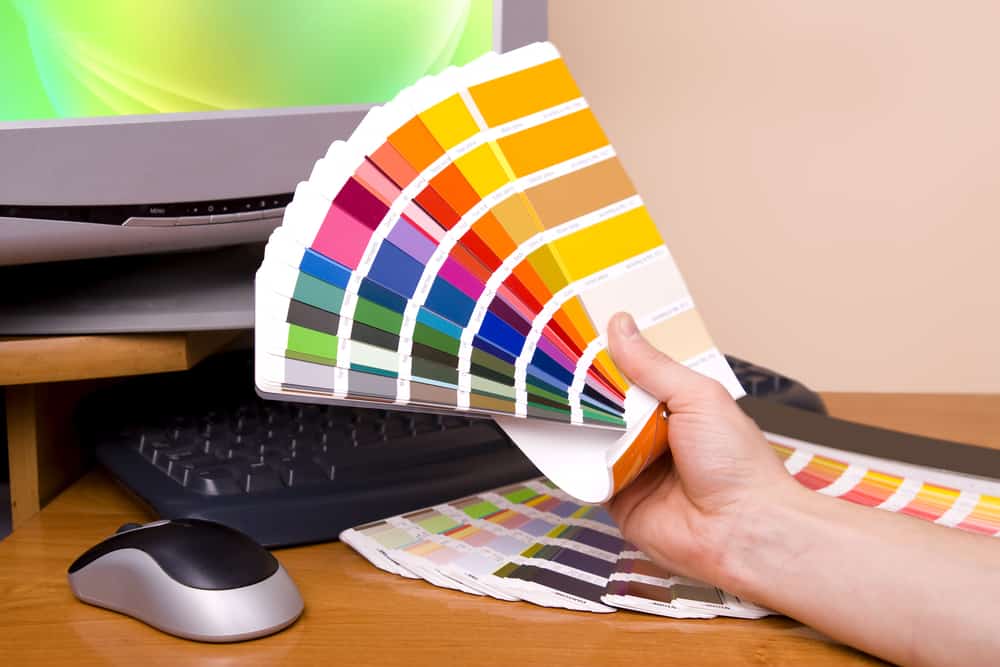This post may contain affiliate links, which means that we get commissions for purchases made through such links, at no additional cost to you. As an Amazon Associate we earn from qualifying purchases.
The printer you need to print labels depends on many factors and there are several options out there, in their hundreds. Our aim in this article is to give you a comprehensive guide on how to choose the right label printer for your printing needs.
What printer do I need to print labels? Laser, inkjet, thermal transfer, and direct thermal printers are the four most common label printer types that people use. However, there are many more varieties of label printing solutions for various printing needs depending on your label size, connectivity, budget, and durability, among other factors.
As you read on, we will show you how to choose between the 4 basic label printer types available. We will also share tips on the major factors that should influence your choice of a label printer.

What Types of Printers Can Print Labels?
There are four most common label printer types. These include inkjet printers, laser printers, thermal transfer printers, and direct thermal printers. If you are looking for a label printer, one of these four types should meet your needs:
When Do You Need A Laser Printer?
You need a laser printer if you intend to use the label printer for business purposes. It has a high output speed, meaning that it can print lots of labels within a short time. It is a very effective option for those who will be handling large printing orders.
Laser printers produce graphics and texts with high quality using laser beams to give the image a high definition and create a fine, clear print (including a vast array of colors). These printers use heat to fix the print to the label paper permanently. So if you are looking for high quality, durability, and fast printing of bulk orders, laser printing is the right choice for you.
When Do You Need An Inkjet Printer?
You need an inkjet printer if you only print labels occasionally in your small office or at home. They are more popular than laser printers because they are cheaper and still produce high-quality prints, including diverse colors on clear labels. But they are not fit for bulk orders.
If you print every day or print in bulk, you will spend heavily on the replacement of ink cartridges.
Inkjet printers propel ink droplets (of various colors) from the cartridge through their printhead nozzle to create images. Since they use liquid ink, you must wait for the ink to dry properly.
When Do You Need A Direct Thermal Printer?
Direct thermal should be your go-to choice if you would be printing short-term labels. These include POS and retail receipts, as well as labels that don’t require archiving. Most thermal printers can only print in one (black) or two (red and black) colors.
Direct thermal labels can’t withstand direct sunshine and other sources of light and high temperatures. These printers are, however, easy to use because they don’t require much supply. They don’t use ribbons, toners, or ink cartridges. Direct thermal will only print on thermal papers (paper labels with special heat-sensitive ink pigments).
When Do You Need A Thermal Transfer Printer?
If you want to obtain a long-lasting label that can resist scratch, thermal transfer printers will be a perfect choice. They also allow you to print on waterproof plastic media. But you must load ribbons (of your preferred color) into the printer before you can print.
Thermal transfer labels are more durable and have a higher quality than direct thermal labels. The printing mechanism uses ribbons that melt under the hot thermal printhead onto the label paper and absorbs itself into it to create a long-lasting imprint.
How Would You Know What Type Of Printer You Have?
If you already own a printer, you can know the type by reading the user’s manual or searching on the internet. You can also try touching and smearing the label to check how warm it is and to see if will bleed or swell. Fresh inkjet prints will smear and fresh thermal prints will be warm.
Here’s how to determine your printer type so that you’ll know if it’s ideal or your needs:
Check The Internet
This is the fastest and easiest way to know your printer type. Check for the name, SKU number, and model of your printer. Then input the details on an online search engine. You would find everything you need to know about your printer, including its type.
Read The User’s Manual
The user’s manual will contain the printer’s data specs and model information. Check these details if you can find your user’s manual. You should see your printer type there.
Try Touching And Smearing
Rubbing the print immediately it comes out of the printer may be a good way to know the type of label printer you have. Inkjet labels, fresh out of the printer, will bleed or swell because they are yet to dry. Meanwhile, thermal and laser printers use heat, so the labels are often warm to the touch when they come out of the printer.
Check The Ink
If there is no ink slot in your printer, then it’s a thermal printer. If the thermal printer uses ribbons, it is a thermal transfer printer. But if it doesn’t use ribbons, it’s a direct thermal printer. More so, inkjet printers typically have only a few cartridges of ink while lasers use bulky toners.
Major Factors for Choosing a Label Printer
You should consider the size of your printer and your label size. Your printing environment matters a lot too. What’s more, you should should check the connectivity options of your printer. Aside from the general overview of the four common label printer types, you should consider these important factors.
Printer Size
There are three sizes available:
Portable printers
These printers are usually so small that you can carry them around. They are a perfect fit for field sample labels and shelf edge labels. You can print with a portable printer and use the label right on the spot. Most portable printers are thermal printers.
Desktop printer
If you have limited space, your best bet would be to purchase a desktop printer. The printers are usually made with plastic, so are not so sturdy. Most desktop printers are thermal transfer printers. They are costlier than portable printers but cheaper than industrial-grade printers.
Industrial Printer
These are often made with metal cases so they can withstand the industrial environment. They can handle very bulky label printing orders. Of all the sizes, industrial printers are the most expensive. They are durable and can print round the clock.
Label Size/Print Width
Most label printers can accommodate 100mm wide label size. But if you want a wider print, buy a printer that can offer you the size you need. Some printers can handle 6-inch print width. However, wider printers would cost you more and the printheads would be expensive to replace too.
Printing Environment
If your printing environment will be a clean indoor laboratory with a print volume of 100 labels daily, desktop printers can satisfy your printing needs. But if you’ll be printing in a dusty environment, such as a factory, with a print volume of 10,000 labels daily ever day of the year, you should buy an industrial-grade printer.
Connectivity
How your printer would receive its printing commands is also very important. The common options available are as follows:
- USB, which is the most popular
- RS232 – Serial, used for connection with older systems
- Wi-Fi
- Bluetooth
- Ethernet
- Memory cards
- Applicator Port
- Near Field Communication NFC)
Be sure of what kind of connectivity you would need and let it guide you in deciding the printer type that you need.
✅ Video – [HOWTO] Turn your USB Printer into a Wireless Printer
You can easily turn your old USB printer into a wireless printer through a very simple process. It seems too good to be true until you watch this video. This video contains instructions on how to enable your old USB printer for wireless printing. You will be amazed that in just 3 steps, your USB printer will be able to print wirelessly.
Radio Frequency ID
If your labels require RFID (Radio Frequency Identification), you need a printer that can print on RFID tags. Only a few printers have this functionality but you can find options ranging from portable to industrial RFID printers that can print a wide range of print width at amazing speeds. If you are looking for an RFID printer, you should read our review of the best RFID printers on the market.
✅ Video – How Retailers Can Print and Encode RFID Tags and Labels
The RFID technology is nothing short of a revolutionizing innovation for businesses. But how can you print RFID labels? How can you encode them? MSM solutions explain it all in this short video. The illustrations they use while explaining will keep you glued to your screen until this video is over.
Related Questions
Do Printers Need To Be Cleaned?
You need to clean your printer regularly regardless of the type. Basic cleaning would keep your printer in good shape for longer and save you the cost of replacing the printhead too often. Regular cleaning also ensures that you get the best quality print at all times.
If you wait too long to clean your label printer, it would start producing smeared pages or distorted prints. You must add cleaning to your regular maintenance routine for crisp printing and increase your label printer’s lifespan.
How Do General-Purpose Ribbons Differ From Industrial Ribbons?
Every thermal transfer ribbon has a similar structure. They all use plastic films with a coat of wax/resin pigment. However industrial ribbons mostly use resin while general-purpose ribbons mostly use wax. As the name suggests, industrial ribbons are specially made for industrial purposes.
Industrial ribbons usually last longer than general-purpose ribbons. They create more durable labels because they are weather-proof and scratch-resistant. However, they are also more expensive.
Can You Use Thermal Transfer Printers For Direct Thermal Printing?
Yes, you can use most thermal transfer printers for direct thermal printing. The only thing is that you won’t add ribbon and you would use direct thermal papers. However, this is risky because abrasion from the direct thermal paper can damage your thermal transfer printhead.
Ideally, thermal transfer printers are not designed to print on direct thermal papers. But the heat from thermal transfer printheads can also create prints on direct thermal papers so long as there is no ribbon between them.
Conclusion
When it comes to label printers, your needs should dictate your choice. But make sure you are not considering your present needs alone. Also, think about what your printing needs will look like in the nearest future and factor it into your decision-making process. In conclusion, make sure you don’t buy a printer that can’t meet your needs and don’t waste your money on an expensive printer that you would underutilize.
